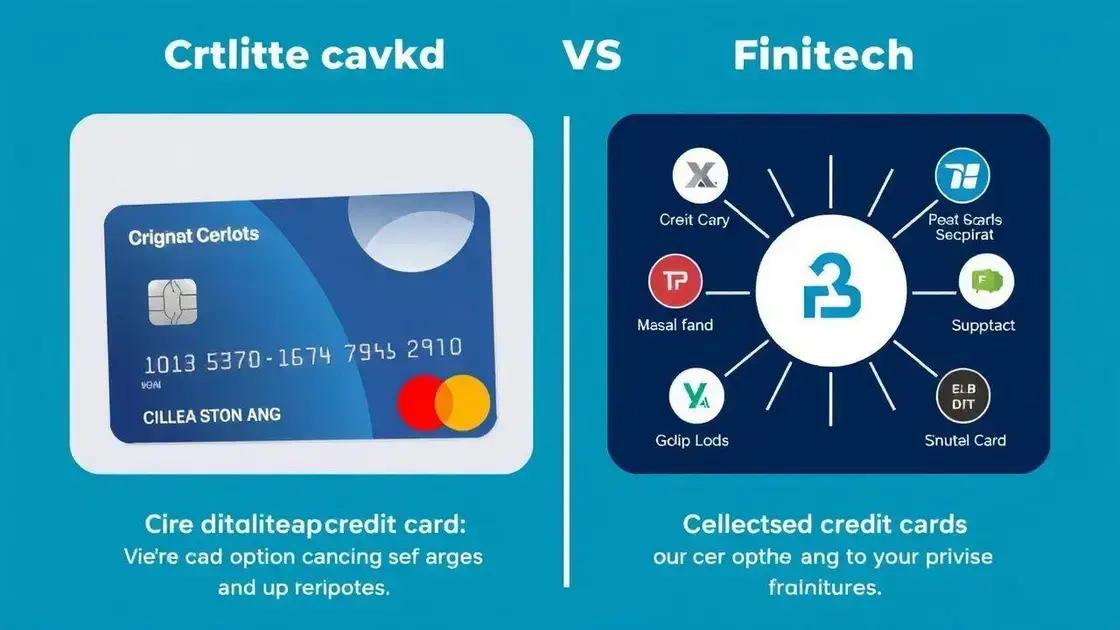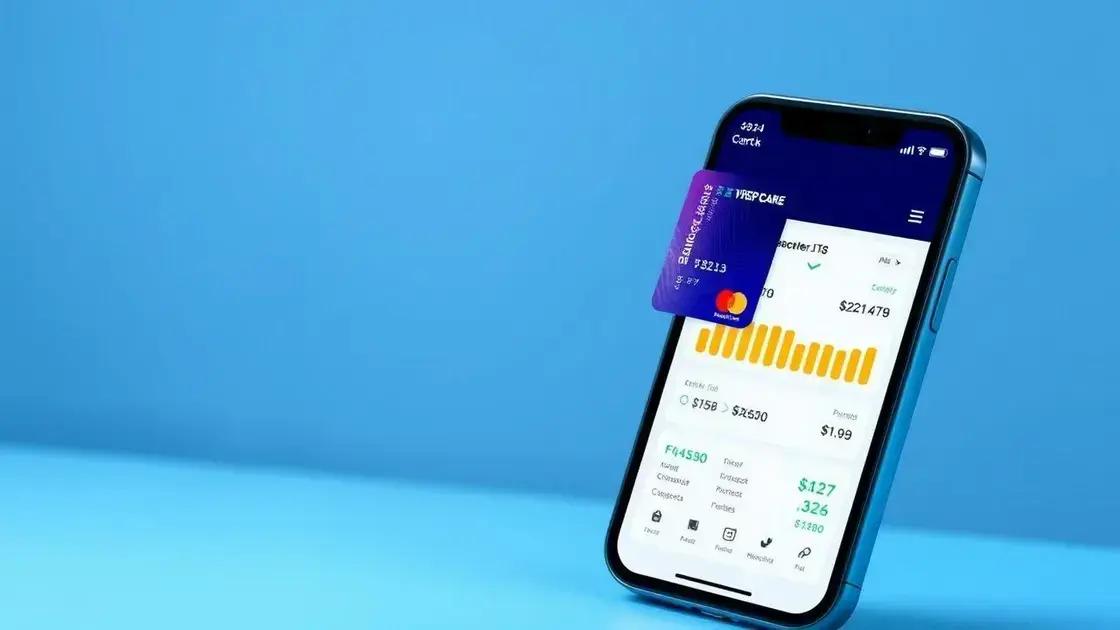Diferencias entre tarjetas de crédito tradicionales y fintech en México

Anúncios
Diferencias entre tarjetas de crédito tradicionales y fintech en México incluem segurança e suporte estabelecido em cartões tradicionais versus baixas taxas e aplicativos intuitivos nas opções fintech, moldando o futuro das finanças no país.
Diferencias entre tarjetas de crédito tradicionales y fintech en México são temas cruciais para quem busca entender o melhor para suas finanças. Você já parou para pensar quais são as principais diferenças entre elas e como elas podem afetar seu dia a dia?
Anúncios
Visão geral de cartões de crédito tradicionais
When we talk about cartões de crédito tradicionais, it’s essential to understand how they operate and what makes them popular. These cards have been a trusted financial tool for many consumers.
Anúncios
Cartões de crédito tradicionais usually come with a bank’s backing, providing reliability and a variety of benefits. They often offer rewards programs, cash back, and other perks that entice users to choose them over others.
Key Features of Traditional Credit Cards
Understanding the key features can help you make informed decisions when choosing a card. Here are some notable aspects:
- Credit limits that are determined based on your credit score.
- Interest rates that can vary widely, especially if payments are not made on time.
- Additional benefits like travel insurance and extended warranties.
Moreover, traditional cards often have a well-established customer support system. This is vital when you have questions or face any issues with your account. Knowing you can rely on customer service can give users peace of mind.
Another advantage is their wide acceptance. Most vendors, both online and offline, accept traditional credit cards, making them a flexible option for shopping.
Potential Drawbacks
However, cartões de crédito tradicionais come with some downsides. High-interest rates can lead to significant debt if not managed properly. Additionally, users may face fees for late payments, which can accumulate quickly.
- Annual fees that may apply for some premium card options.
- Penalties for late payments and over-limit charges.
- Less flexibility in payment options compared to fintech cards.
Understanding these pros and cons can help consumers choose what works best for their needs and how to navigate their finances more effectively with traditional credit cards.
Como funcionam os cartões de crédito fintech

When discussing cartões de crédito fintech, it’s important to understand how they operate in a uniquely different way compared to traditional credit cards. These fintech cards leverage technology to provide a user-friendly experience that appeals to many consumers today.
Unlike conventional cards, cartões de crédito fintech often use mobile apps to manage accounts, track spending, and offer insights. This digital approach allows users to stay informed about their finances in real-time.
How Fintech Credit Cards Work
Essentially, these cards connect directly to your bank account or to a separate digital wallet. This provides a seamless experience where transactions are fast and efficient. Here’s how they typically function:
- Instant approvals and setup through an app, allowing for quick access to funds.
- Low or no fees compared to traditional banks, making them an attractive option.
- Real-time notifications about transactions to help you manage your finances better.
Moreover, many cartões de crédito fintech offer innovative features like budgeting tools and automated savings, which can help users cultivate healthier financial habits. These features often encourage responsible spending by providing insights into financial behavior.
As we explore further, you’ll find that security is a significant focus for fintech companies. Many employ advanced technologies to ensure your data remains safe, utilizing encryption and biometric authentication methods.
Benefits of Using Fintech Cards
Fintech credit cards also come with various advantages that are appealing to new users. Here are some key benefits:
- Flexibility in payment options, including the ability to pay later or in installments.
- Access to rewards programs tailored to your spending habits.
- Customer support that is often available 24/7 through the app.
The combination of technology and financial services makes these cards attractive to a younger demographic looking for convenience. Overall, cartões de crédito fintech are reshaping how we think about credit and spending.
Vantagens e desvantagens dos cartões de crédito fintech
When evaluating cartões de crédito fintech, it’s essential to consider both their advantages and disadvantages. This understanding will help you make informed choices about using these modern financial tools.
One of the most significant advantages of cartões de crédito fintech is the low fees they typically charge. Many fintech companies focus on reducing overhead costs, which allows them to offer cards with little to no annual fees.
Advantages of Fintech Credit Cards
Here are some key benefits:
- Instant access to funds with quick approval processes.
- User-friendly mobile apps for managing transactions and monitoring spending.
- Innovative budgeting tools integrated into the apps to help users manage their finances.
- Rewards programs that often cater to individual spending habits.
These benefits make them especially appealing to younger consumers who value convenience and technology in their financial services. Additionally, fintech cards typically provide real-time notifications about transactions, helping users stay aware of their spending.
However, it’s important to consider that cartões de crédito fintech also have some drawbacks. For instance, while they offer a wealth of digital features, not every fintech card is accepted everywhere. This can be limiting when traveling or shopping at certain retailers.
Disadvantages of Fintech Credit Cards
Some challenges users might face include:
- Potential security concerns as some fintech companies may not have the extensive security measures of traditional banks.
- Lack of face-to-face customer service in many cases, which can be a drawback for those who prefer in-person assistance.
- Some accounts may have limitations on credit limits based on the user’s financial history, which can restrict usage.
Understanding both the pros and cons of cartões de crédito fintech allows users to weigh their options wisely. This knowledge empowers individuals to choose cards that align with their financial needs and lifestyles.
Segurança e proteção em cartões tradicionais versus fintech

When considering segurança e proteção in financial transactions, the differences between traditional credit cards and cartões fintech become crucial. Both options have their unique security measures to protect users’ financial information.
Traditional credit cards often come with robust fraud protection offered by banks. Many institutions monitor transactions for suspicious activity, alerting users immediately if potential fraud is detected. This safety net provides assurance to many consumers who value established banking practices.
Security Features of Traditional Credit Cards
Key security features typically include:
- Monitoring systems that track and analyze transactions to catch fraud early.
- Zero liability policies ensuring consumers are not held responsible for unauthorized charges.
- Chip technology which adds an extra layer of protection when making purchases.
However, as technology evolves, cartões fintech are also adopting advanced security features that are appealing to tech-savvy users. Fintech companies prioritize user experience, incorporating real-time alerts and biometric security measures such as fingerprint and facial recognition.
Security Features of Fintech Credit Cards
These cards often emphasize:
- Instant transaction notifications, giving users immediate awareness of their spending.
- Encryption methods that secure user data and transactions from cyber threats.
- Control over card settings, enabling users to freeze or unfreeze their cards instantly via the app.
While fintech cards are growing in popularity, users must still exercise caution. Understanding the security features of both traditional cards and cartões fintech can help consumers make informed decisions about which card aligns best with their security needs.
O futuro dos cartões de crédito no México
The future of cartões de crédito no México looks promising as technology and consumer preferences evolve. With the rise of fintech solutions, traditional credit cards must adapt to remain relevant in a competitive market.
As we look ahead, several trends are likely to shape the landscape of credit cards in Mexico. First, there is an increasing adoption of digital wallets and mobile payment solutions. Consumers are embracing the convenience of making purchases directly from their smartphones.
Emerging Trends in Credit Cards
Here are some significant trends influencing the future:
- Increased integration of artificial intelligence for personalized financial services and alerts.
- Expansion of contactless payment options, making transactions faster and safer.
- Focus on sustainability, with more companies offering eco-friendly card materials.
Moreover, the demand for more control and transparency is prompting fintech companies to provide advanced budgeting tools directly in their apps. This allows users to track their spending and manage their finances more effectively.
As competition grows, we can also expect traditional banks to enhance their offerings. They might introduce innovative features to attract younger consumers who prefer digital solutions. This could mean better rewards programs and more user-friendly interfaces on banking apps.
Regulatory Changes and Consumer Trust
Regulatory changes will also play a crucial role in how cartões de crédito no México evolve. Government policies aimed at protecting consumers and ensuring fair lending practices will reshape the market. Consumer trust will be essential for both traditional and fintech options. Companies that prioritize security and user experience are likely to succeed in this changing environment.
Overall, the future of cartões de crédito no México will be characterized by technological innovation and a focus on customer-centric solutions. Staying informed will help consumers make better choices regarding their financial needs.
FAQ – Frequently Asked Questions about Credit Cards in Mexico
What are the main differences between traditional credit cards and fintech credit cards?
Traditional credit cards are backed by banks and often provide established security and customer support, while fintech cards focus on low fees, user-friendly apps, and innovative features.
How do fintech credit cards enhance security for users?
Fintech credit cards use technology such as real-time notifications, encryption, and biometric authentication to provide a secure experience for users.
Will traditional credit cards become obsolete because of fintech options?
While fintech options are gaining popularity, traditional credit cards will likely continue to exist, especially for users who value established bank relationships and services.
What should I consider when choosing between a traditional and a fintech credit card?
Consider factors like fees, security features, ease of access, and the specific benefits each type offers to determine which card best suits your financial needs.